Officials don't want Florida to become next home for this invasive species. Here's what you can do
Meet the spotted lanternfly.
A native of China, the insect was discovered in Pennsylvania in 2014 and has since spread to 17 states, according to the U.S. Department of Agriculture. The insect is a voracious eater that feeds on woody and ornamental trees as well as a wide variety of crops and plants.
Some of its favorite meals include apple, birch, black walnut, grapes, maple, poplar and stone fruits. It's especially attracted to the tree of heaven.
While the tree of heaven has been documented in Florida as far south as Hillsborough County, it's relatively scarce in the Sunshine State, according to the Florida Department of Agriculture and Consumer Services Division of Plant Industry. Thank heaven (pun intended).
Here's what you should know about the spotted lanternfly and how you can help prevent its spread.
What is the spotted lanternfly?
The spotted lanternfly, Lycorma delicatula, is an invasive planthopper.
It feeds on sap from several types of plants, according to the Pennsylvania Department of Agriculture.
Where is the spotted lanternfly?
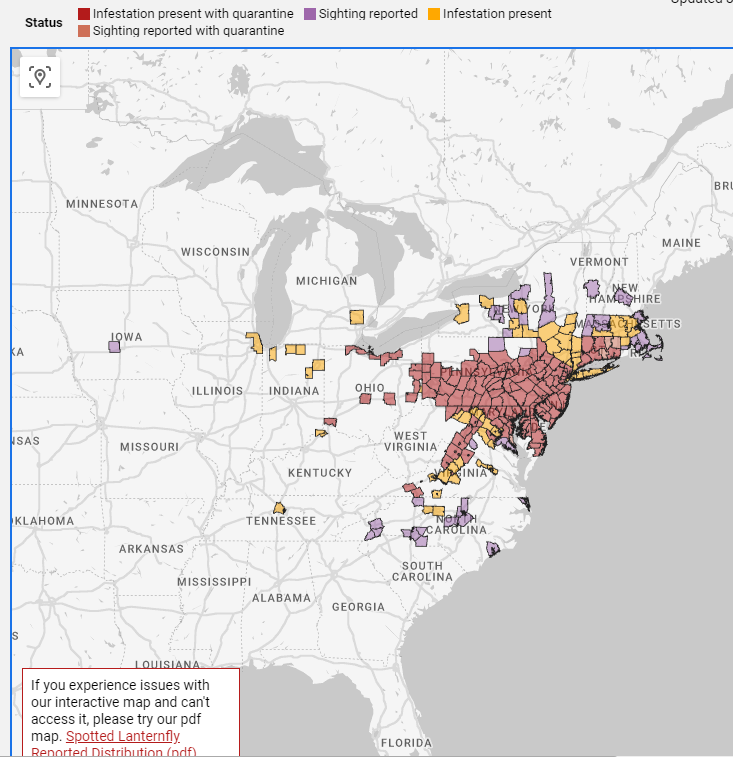
Infestations of the spotted lanternfly can be found across the Northeast, especially in Pennsylvania, New Jersey, Maryland, New York, Connecticut, Rhode Island and Massachusetts.
Infestations have also been reported as far west as Iowa and as far south as South Carolina.
Map: See reported infestations in the Northeast
Spotted lanternfly 'excellent hitchhiker'
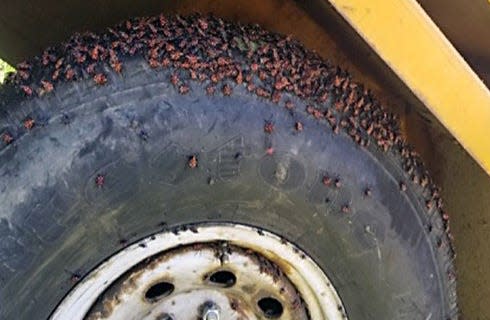
The New Jersey Department of Agriculture has declared battle — “Join the Battle, Beat the Bug” — to stop the spread of the spotted lanternflies.
"This insect is an excellent hitchhiker and is easily moved if no one is looking. If you are in the quarantine area — which includes all of New Jersey — please “Look Before You Leave.”
New Jersey officials recommend motorists inspecting their vehicles, trailers, or any outdoor items before you move around or out of quarantined area.
"If possible, don’t park under tree lines and keep windows rolled up when parking your vehicle. Any efforts you make in destroying the Spotted Lanternfly or its egg masses will help you and community reduce populations.
"If you see a spotted lanternfly, help us Stomp it Out!," New Jersey officials said.
Should Florida be concerned about the spotted lanternfly?
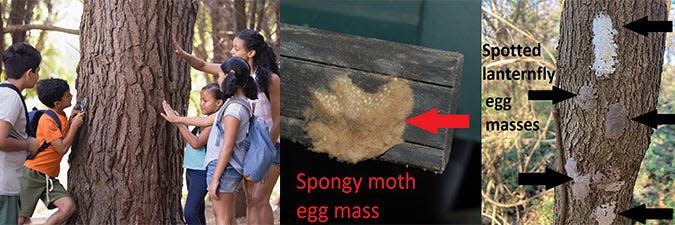
While the spotted lanternfly's preferred host plant, the tree of heaven, is relatively scarce in Florida, that doesn't mean it wouldn't be able to find alternatives.
The Florida Department of Agriculture and Consumer Services said other potential host plants found in Florida include the chinaberry and Virginia creeper, which puts "Florida at some risk for establishment of this pest."
Since egg masses can be laid on such items as lawn furniture, homes, vehicles or storage containers, the insects could make their way to the Sunshine State.
What does the spotted lanternfly look like?
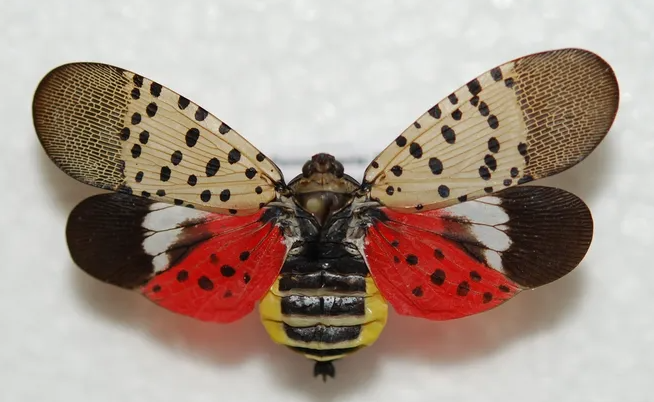
The Florida Department of Agriculture provided these descriptions:
Adults are large, about one-inch long and a half-inch wide. Adult forewings are tan-gray with large black spots, and the tips have a fine, interlaced black pattern. Adult hindwings are red with black spots at the base and a white band across the middle and black tips. The hind wings are colorful and distinctive but concealed at rest.
Younger nymphs are black with white spots, and older nymphs are black and red with white spots.
The egg masses are distinctive. Thirty to 50 eggs are encased in material that dries to the consistency of dried mud. Egg masses can be attached to any surface. The completed egg mass is typically gray and can be one to two inches long.
The Florida Department of Agriculture advised residents to be on the lookout for spotted lanternfly and its egg masses, which can be found on objects and plant materials imported into Florida from infested states.
There are no Florida insects that resemble this species in size and color pattern, officials said.
What to do if you see a spotted lanternfly or egg mass in Florida
Send a photo to the DPIHelpline@FDACS.gov or call the DPI helpline at 1-888-397-1517.
Scientist in Florida discovers spotted lanternfly as an 'Achilles heel'
In an article posted in January, Richard Mankin, an entomologist with the USDA Agricultural Research Service’s Center for Medical, Agricultural, and Veterinary Entomology in Gainesville and colleagues found a new way to potentially corral and control the spotted lanternfly: It's attracted to vibrations.
“There were rumors that lanternflies are attracted to vibrations of buzzing electrical power lines, so we did a laboratory study of nymph and adult responses to 60-cycle (60Hz) vibrations,” Mankin said. “The rumor proved to be correct! Both nymphs and adults walked towards the source of [the] vibrations.”
"Using vibration to entice the lanternflies to gather is a major step toward improving control methods. Mankin said further research will focus on traps and finding ways to disrupt the spotted lanternfly's mating behavior.
Does the spotted lanternfly sting or bite?
The spotted lanternfly will not sting or bite humans or animals, according to the New Jersey Department of Agriculture.
Why should we be concerned about the spotted lanternfly?
The spotted lanternfly has a "strong preference for plants" that can be important to a state's economy, including grapevines. Feeding can lead to a plant's death.
"The SLF can impact the viticulture (grape), fruit tree, plant nursery and timber industries, which contribute billions of dollars each year to PA's economy," according to the Pennsylvania Department of Agriculture.
"A 2019 economic impact study estimates that, uncontrolled, this insect could cost the state (Pennsylvania) $324 million annually and more than 2,800 jobs."
As they eat, the spotted lanternflies excrete honeydew, a sugary waste that attracts bees, wasps and other insects. As the waste builds up, that can lead to the growth of sooty mold and black-colored fungi, officials said.
What can you do to help prevent the spread of the spotted lanternfly?
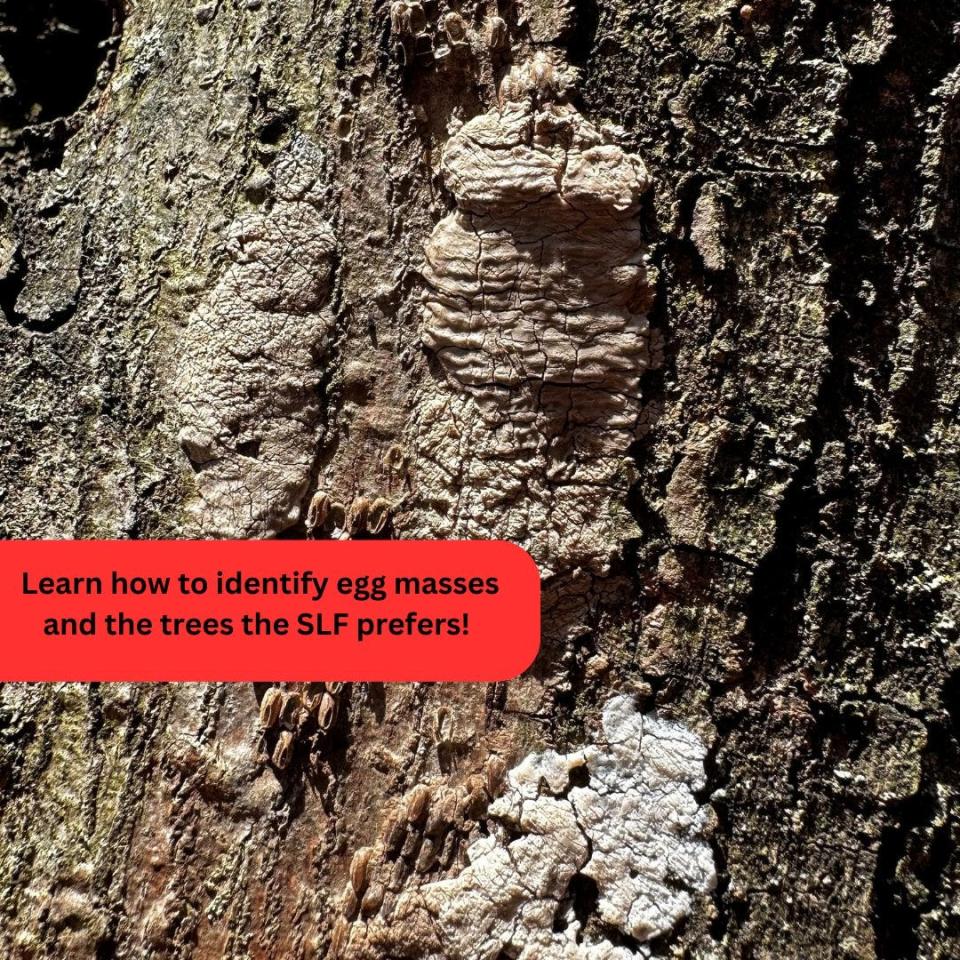
The U.S. Department of Agriculture offered this advice:
The average person can have a huge impact. Here are a few tips:
Smash and scrape egg masses during late fall, winter, and early spring, when these pests are dormant in their egg mass life stage. Invasive pest egg masses can travel long distances on the items people travel with and can start infestations in new parts of the country.
If you live in a quarantine area, your state department of agriculture will have guidance posted specific to your area.
If you are passing through or leaving a spotted lanternfly quarantine area, check your vehicle, and your belongings for all life stages of these pests.
If you are moving outdoor furniture or a recreational vehicle and camping equipment, check for flat, mud-like spotted lanternfly egg masses. If you find these pests in quarantine areas, smash them, and scrape them off, so you don’t accidentally move them to new places.
Don’t move untreated firewood to new places. It can easily introduce invasive pests that kill or defoliate forests. Source firewood where you will burn it or buy certified, heat-treated firewood before you travel.
If you live in an area where these pests are not established and see a spotted lanternfly, or any of their life stages, please report the sighting to your state’s Department of Agriculture.
This article originally appeared on Treasure Coast Newspapers: Spotted lanternfly: How Florida can keep invasive species away

